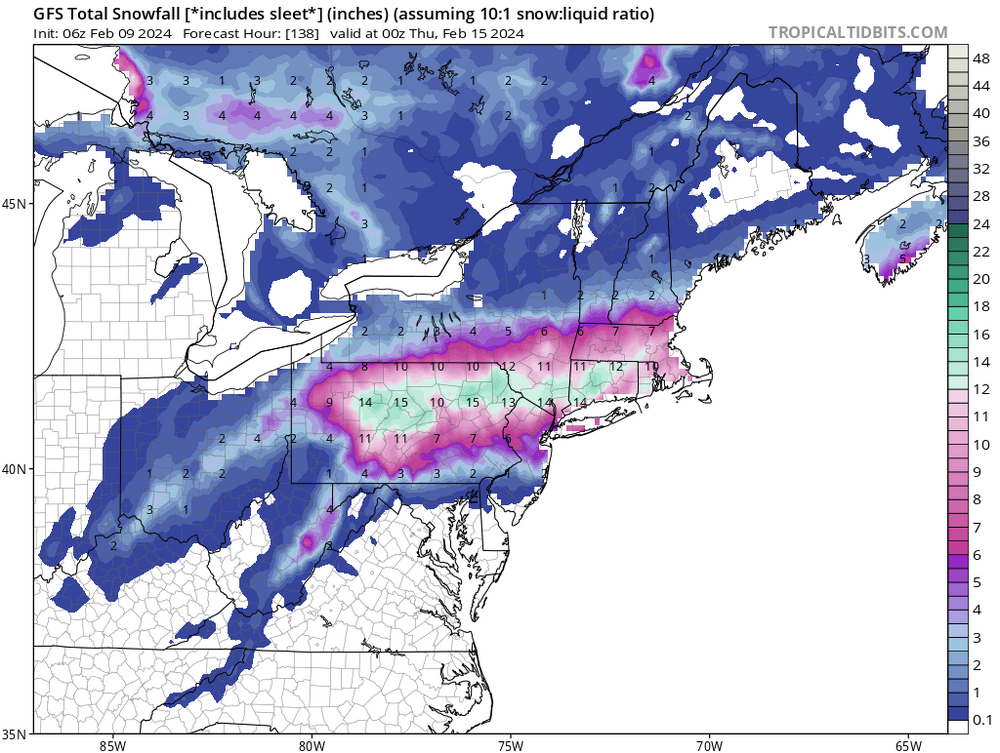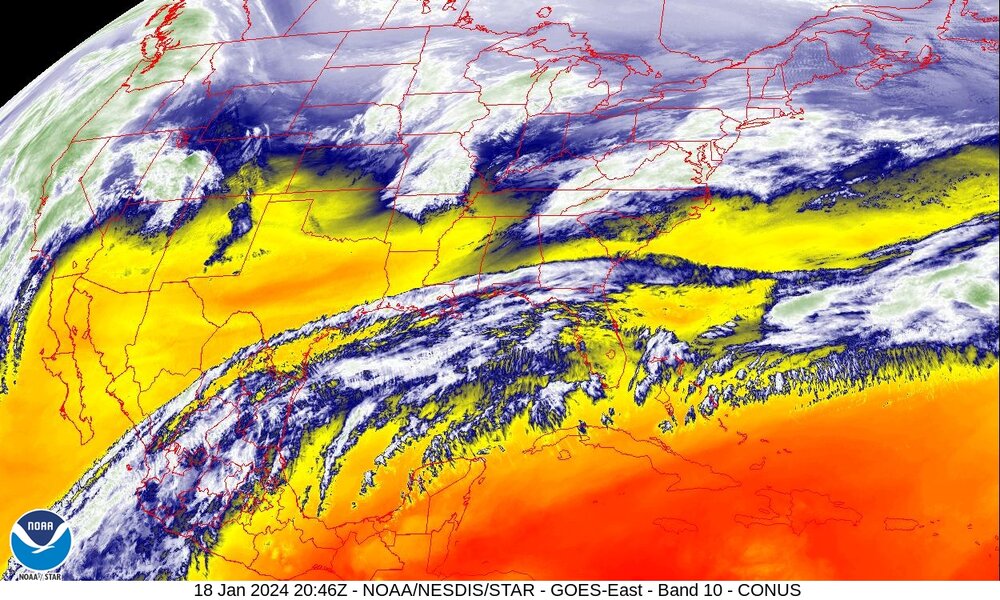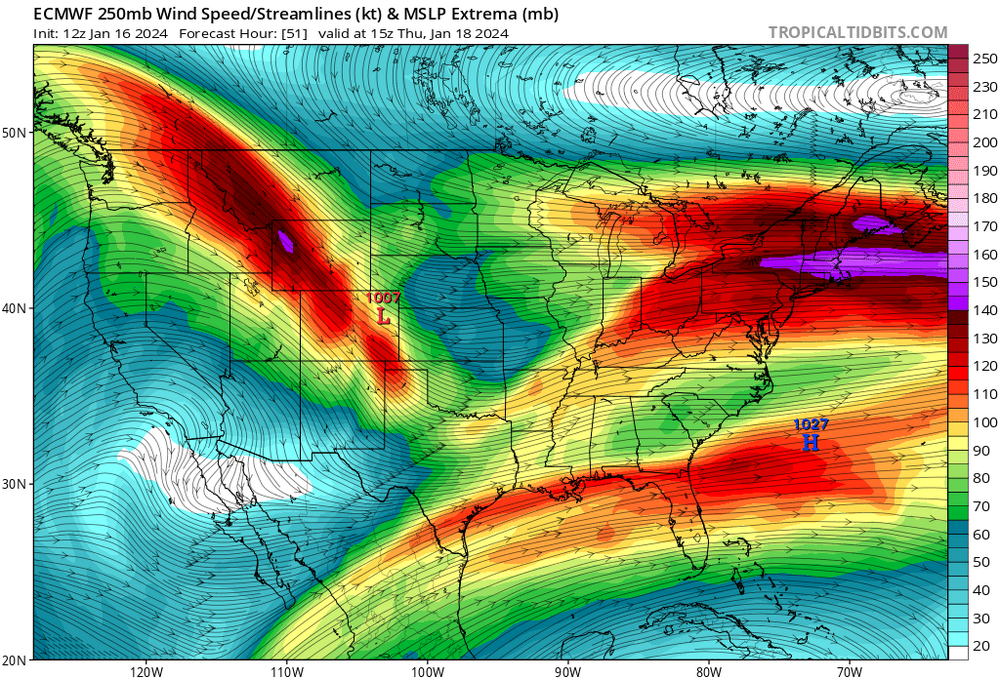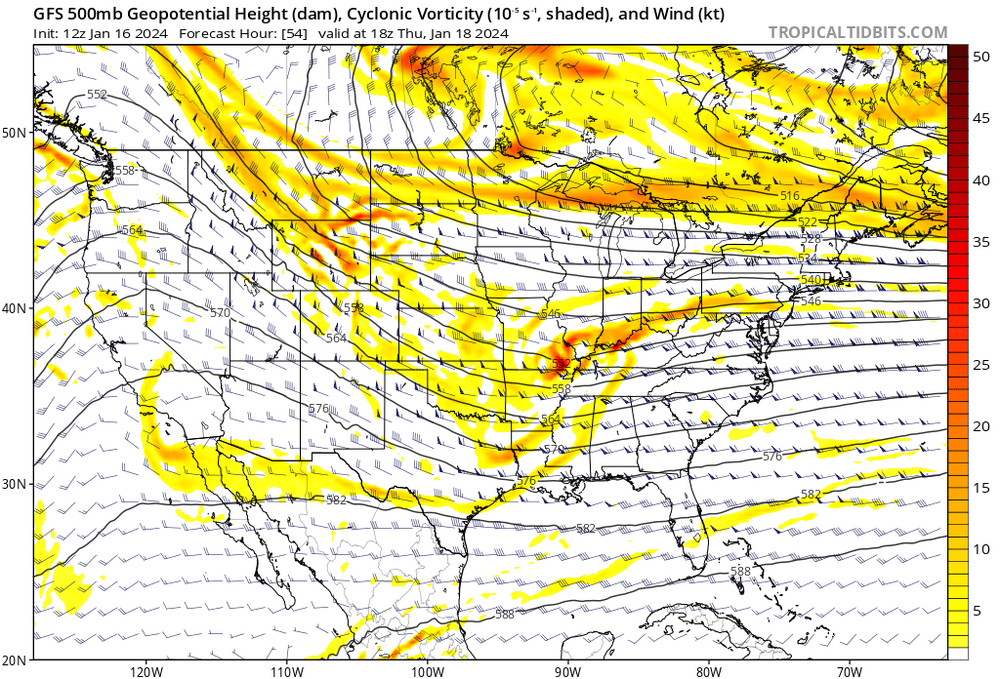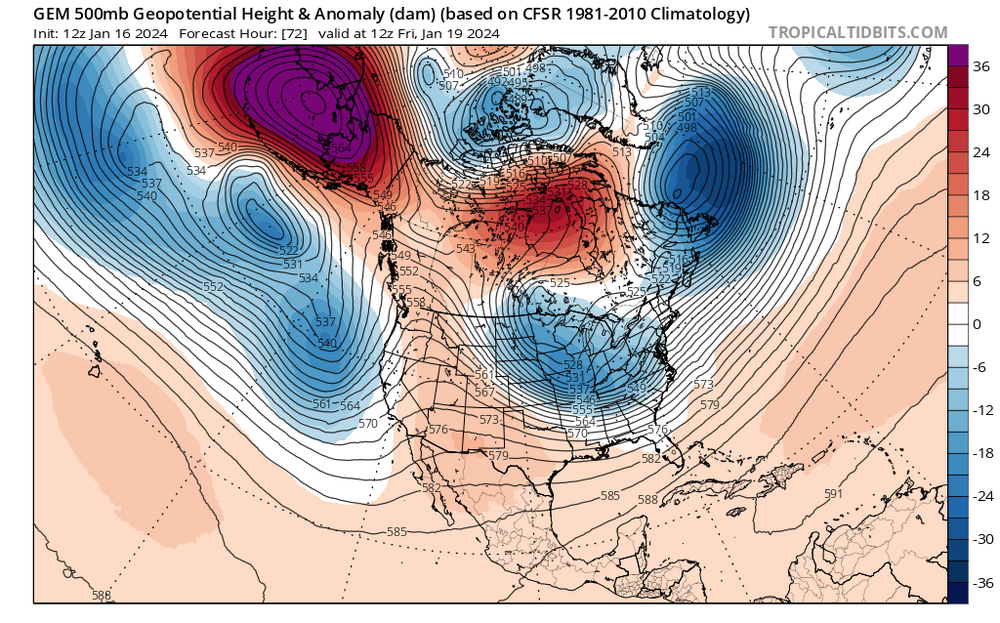-
Posts
1,231 -
Joined
-
Last visited
Content Type
Profiles
Blogs
Forums
American Weather
Media Demo
Store
Gallery
Everything posted by jwilson
-

Pittsburgh, Pa Winter 2023-24 Thread.
jwilson replied to meatwad's topic in Upstate New York/Pennsylvania
The latest convergence we see is actually between the Euro, Canadian, and Ukie with a lower northern component (almost a non-event now) and more of an eastern component, which probably makes more sense if you think about. Consider the southern solutions from before were modeled that way because of stronger and faster confluence coming out of the NS. This is acting as a kicker and preventing much deepening or negative-tilt prior to the storm advancing out to sea. That likely puts the better CCB/deformation banding to areas east of us. I basically ignored the idea that the CMC and Ukie could be right and figured the Euro and GFS combined were a safer duo. That's a whoopsie, and if the former score a coup on this storm, I think I'm done predicting or analyzing anything this winter. Considering how much things have changed in 24 hours, it's difficult to say anything is finalized now, but there appears to be a bit more agreement as compared to 12Z yesterday. We're still dealing with a marginal airmass and bad surface thermals. This is evidenced by the fact that we have an ideal vort pass on all three levels (south of us), but we're still struggling to generate snowfall. If the storm is kicked east quicker, that part aligns, because the deepening which generates the cold air we need occurs out of our zone. The GFS is sort of on its own again, but it jumped south significantly between 12Z and 18Z. Oil City went from 15" to 3" in one run. That could very well mean it is beginning to fall in line with the other guidance. Another 24 hours will tell the tale. -

Pittsburgh, Pa Winter 2023-24 Thread.
jwilson replied to meatwad's topic in Upstate New York/Pennsylvania
The CMC is the only one of the majors that keeps it an open wave, meaning the lows - at all levels - never close off. So the s/w doesn't deepen and it bounces along the confluence out to sea. It's subtle, but it is also a tad bit stronger and further south / faster with the confluence. There's a suppressive element to that difference. There's not a ton of NS energy getting phased into the center in any case. The good and bad of that is we have a cap on how far north it can realistically go, but it also means we cap how deep the storm can intensify. Most of that energy acts more of a kicker to knock the system East, which also means the center of LP stays farther away and limits its influence on us. Obviously, we're coming into this event with extremely marginal cold air. It's going to be 50 degrees Monday. In a system like this, that doesn't matter quite as much, but the antecedent thermals are always relevant to some extent. Both the Euro and GFS are now keeping the better totals north of PIT metro. Based on experience, I think I see enough red flags to bail on this one, at least here in the South Hills. I'll be happy if I'm wrong, but I would honestly be quite shocked to see this one come back south and bullseye the Pittsburgh localities. That would go against conventional wisdom. Not saying it's impossible, but I'm playing the odds here - if you're into betting, it's like taking the favored home team. -

Pittsburgh, Pa Winter 2023-24 Thread.
jwilson replied to meatwad's topic in Upstate New York/Pennsylvania
I wasn't buying into the GFS solution because it didn't have any support before now. The 0Z Euro managed to pop a mini jackpot over Allegheny County. We're threading the needle, but if you want a possible snow solution, the Euro - at least temporarily - backed off the cutter idea. If that holds at 12Z I'll be slightly more interested. You can see the potential thermal issues, however. The GFS warm tongues us and although the heaviest swath of snow is generally in the same area, it extends a tad further north. It's a delicate setup, to be sure. -

Pittsburgh, Pa Winter 2023-24 Thread.
jwilson replied to meatwad's topic in Upstate New York/Pennsylvania
The storm around Valentine's Day was what I expected to be our initial cutter that helped set the pattern going forward. Others have already said it, but if we want that one to be snow, we need perfect timing of the phase. I don't generally like betting on those types of storms because of all the ways they can fall apart. That doesn't mean it can't happen, however. If it does miss, I don't think it's a big deal in the grand scheme of things. If we get a hit, that's a massive bonus. The question is what happens after, because right now the OP models are sort of kicking the idea of an established -NAO. The ensembles still seem to have it in the long range, but it's not developing in the same way it was before. If you go back in time, you can see the ensembles started establishing the -NAO around the 17th after the bowling ball shortwave resets the table. The latest runs push it to the 20th and it's a retrograded Scandinavian block instead. Maybe this is delayed instead of cancelled, but it's enough to raise an eyebrow. The OP GFS isn't showing a -NAO at all, even in fantasy land. Now the GFS has been particularly bad this year, but the Euro and Canadian only give a faint appearance at the very end of their latest respective runs. We're going to have to wait a bit longer for resolution. Now that's all "meta" pattern talk and not necessarily relevant to the individual storm threats we may face. Right now, the President's Day threat looks like a classic Miller A, but it's fairly basic overrunning wave that gets squashed by the NS plunge. There's zero interaction between the two streams. Verbatim that event has a capped ceiling. It's northward progression is dependent upon timing and strength of the cold boundary. Unfortunately, you have those two lower pressures sinking at the same time, with the energy in the southwest shrinking away from the NS, instead of say a basic western ridge that forces the NS energy down into the CONUS. In the north, it's a classic Rex Block. That stalls that cold air bubble a bit longer rather than allowing it to make West-East progress and get out of the way. What I'm perhaps most interested in, for now anyway, is what happens after the PD event. It looks wonky in the interim, but it won't resolve that way and ultimately doesn't matter quite yet. If you freeze the 12Z OP GFS at 300 and overlay with the ensembles, you can see the potential. I do think it's also possible, however, we end up kicking a better established pattern into March. And I hate to phrase it that way but this is the danger of long-term tracking. The good news for now, even if that happens, we have threats to watch. -

Pittsburgh, Pa Winter 2023-24 Thread.
jwilson replied to meatwad's topic in Upstate New York/Pennsylvania
I agree with you here. This isn't the character of a winter with a longer term sustained cold regime, really. I suppose we could have something that spurs such an event, like one of the teleconnections goes off on a wild tangent at a significant magnitude and alters the character. I would suspect the -NAO block isn't stable for a significant period. Right now I would favor 70/30 odds of a two-week ceiling like we had earlier, meaning 70% chance the block breaks down faster than expected. The longer-term looks on ensembles could simply be due to the smoothed mean. The real trepidation for us here is the entrenched block suppressing the big fish to our south or off the coast and the precip shield misses us. Most likely what's hurt Pittsburgh in previous Nino conditioned winters. Those blocks can often move the boundary beneath us. The saving grace is the time of year, perhaps, in that it is happening in late February / early March as opposed to earlier in winter. Then again, the groundhog told us we'd be in for an early spring. That should guarantee sustained winter through March. -

Pittsburgh, Pa Winter 2023-24 Thread.
jwilson replied to meatwad's topic in Upstate New York/Pennsylvania
Thus far, it is the warmest winter in modern or recent history. The only dates beating it are from 1890, 1932, and 1880, so for me that data is incongruous and largely irrelevant. The other contemporary date in the Top-10 is from last year, unsurprisingly. -

Pittsburgh, Pa Winter 2023-24 Thread.
jwilson replied to meatwad's topic in Upstate New York/Pennsylvania
We're still really a week to 10 days out from determining the extent of the pattern change. By that point, we'll be much closer to the transition period to see if things still progress as long-range guidance implies. Ensembles haven't budged much. The mid-week Omega Block didn't work out because we basically have a double-ridge that moved too far to the East, which blocks the trough out into the western Atlantic. Sort of a trend this year - we can't get the boundary interaction and timing exactly where we want it. We'll have to deal with at least one cutter, I would think, before the shift in the block and jets. Right now it's just a waiting game. -

Pittsburgh, Pa Winter 2023-24 Thread.
jwilson replied to meatwad's topic in Upstate New York/Pennsylvania
I'm repeating myself a bit here, but my expectations for this winter were set at 30" based on historical analogs. That was basically the ceiling for Pittsburgh during +2.0 Nino events (we peaked at +1.9, I think, but that's hair-splitting). It's a below average winter for us, by far, but since my expectations were relatively low, I'm not too surprised by how things have gone. My only inkling was that maybe we'd hit a big storm this year - and that would essentially be the source of most of our season's snowfall. I'm generally fine with such an outcome. The eight years it has been since a 20" storm is the longest I've gone in my life not seeing something of that magnitude. It's obvious by now that this wasn't going to be a wall-to-wall winter with infinite opportunities. I guess chances might favor we get a repeat of January with a 14-day threat window where cold and precipitation align. Like you, I don't necessarily care as much once we get into March, but March is quite capable of producing big winter events. Just two years ago Pittsburgh got >17" in March, but someone will have to fill in the blanks for me because I don't remember how that happened (2022 was a weird year for me). Pittsburgh's biggest storm ever was in March, of course, but I guess since that was such a fluke thing it's mostly irrelevant. Only point being that even if we end up moving the window later in February or back into March, there's still chances to be had. Our window is open a bit longer than places south and east. -

Pittsburgh, Pa Winter 2023-24 Thread.
jwilson replied to meatwad's topic in Upstate New York/Pennsylvania
I think anything we might score in terms of snowfall before Valentine's Day would be considered a bonus given the overall pattern. There's an interesting Omega Block setting up around the 7th that's worth keeping an eye on as long as it stays. Getting the requisite cold is going to require an anomalous low, in all likelihood (meaning something really wrapped up). Big issues right now are +EPO, +AO, and +NAO keeping the cold out of North America. The MJO is supposedly dying in Phase 7 which isn't ideal, but that's the lesser of the problems. The velocity of the pattern change is what remains our big question. Do we get sufficient movement by President's Day? Late February is one of those odd times where big storms seem much less common, then March becomes the coin-flip month. -

Pittsburgh/Western PA Banter & Complaint Thread
jwilson replied to blackngoldrules's topic in Upstate New York/Pennsylvania
Pittsburgh's 20-year average (45.60) is up slightly over the 30-year average (43.04), but the average is actually down below that 30-year number if you don't include 2010, which remains a pretty high outlier. I realize this is "cheating" to some degree. I don't put much stock in older climate numbers, either. Stuff from the 1890s and early 20th century is so unreliable, and it isn't an apples-to-apples comparison to our modern data collection methods. I realize they use it because they have it, and we're dealing with a relatively minute dataset as it is even including those years. It's just a grain of salt interpretation for me. Even the more recent 30-year average is such small sample size relative to all our climate history. It's almost impossible to know the extent to which things are changing in terms of snowfall amounts and so forth. There's a few things we do know, which is disruption of the northern jet because of a warming pole, melting sea ice, etc. We've been stuck in a longer-term Nina-like base state and -PDO, but I don't know if that's related to climate change or merely cyclical, or perhaps both. That disruption of the northern jet is likely why we haven't experienced as many clippers of late - the jet often dips south of us or is off-kilter from our latitude. It's not as consistent anymore. That's my theory, anyway. Also why textbook Miller As are less common (and a lack of Ninos). The other clear change is SSTs and how much warmer the ocean is, which is partly why the coastal plain has struggled for snow lately. Although the warmer oceans worldwide disrupt our weather patterns more esoterically, the local Atlantic temps create opportunity for bombogenesis-type events with increased frequency. This is where you perhaps get into a feast-or-famine pattern that means big storm and snow or anything smaller is rain. The ocean is less geographically relevant for us, of course. -

Pittsburgh, Pa Winter 2023-24 Thread.
jwilson replied to meatwad's topic in Upstate New York/Pennsylvania
This would be a complete fluke storm if there ever was one. Hostile pattern mostly, minus the western ridge in a good location. But as you said, the cold is scoured out of NA by that +EPO. We'd have to time this right underneath the rotation of the TPV lobe over Hudson Bay and dig a s/w deep enough to produce its own cold sector. The ensembles look better because they have a stronger lobe that reaches a bit further south. Makes enough changes to the eastern trough. If the s/w comes in a bit later behind the lobe and still amplifies, it cuts west of us, and there's nothing to stop northern progression. -

Pittsburgh, Pa Winter 2023-24 Thread.
jwilson replied to meatwad's topic in Upstate New York/Pennsylvania
I measured 2.6" before any bands might come through. -

Pittsburgh, Pa Winter 2023-24 Thread.
jwilson replied to meatwad's topic in Upstate New York/Pennsylvania
You can see the center of that coastal circulation well off the North Carolina coast (and moving due East). You can also see the flat confluence up in Quebec and how we don't have much lift across the region (low cloud tops). What we had today was the result of separation between two pieces of NS energy. They never got their act together as a team. They stayed separate and we were basically stuck in an area of general "subsidence" (basically between two more organized areas of convection). Think what happens when you're on the edge of one of those intense convective bands of snow. If you're under the band you're getting great rates, but if you're immediately outside the band, it's mostly dry. The air is flowing downward instead of upward. That's what happened on a macro-level, more or less. We experienced the weaker region of lift, but we'll still hit our snowfall targets because of the higher ratios and light winds aloft. It's lower-end, sure, but still within the margins. -

Pittsburgh, Pa Winter 2023-24 Thread.
jwilson replied to meatwad's topic in Upstate New York/Pennsylvania
There's a bit of dry air in between the s/w's, but you can really see the separation of the jet steams in this shot. Too bad because we would have quite the moisture pool to tap into down there. -

Pittsburgh, Pa Winter 2023-24 Thread.
jwilson replied to meatwad's topic in Upstate New York/Pennsylvania
2-6" seems like the appropriate call. If we pick up about 0.20" of precipitation, at 10:1 that's 2", but with temps in the low 20s we could go anywhere from 15-to-20:1 (loosely and disregarding dendrite growth analysis). Probably nothing higher than that. There's no frontogenesis or dynamics associated with redevelopment. This is a slightly juicier clipper. More of a duration and shield-dependent event. -

Pittsburgh, Pa Winter 2023-24 Thread.
jwilson replied to meatwad's topic in Upstate New York/Pennsylvania
Mesos trending to strengthen the primary and squash the secondary. If we wanted a maxima result, we'd want the secondary to develop, tuck, and throw the CCB back across us. As it is now, it looks more like a traditional clipper. Makes sense given the lateral flow. The NBM juiced our totals over the last run to almost 4" average (with >2" at high probably of 91%), up from the 2.7" the previous run. Next update is 19 UTC so worth watching which way that moves considering the latest mesos. A disagreement, of sorts? SREF mean is at 2.7" (ironically) and GEFS average is irrelevant, unfortunately, because the computer is down. Last plumes were from 0Z 1/16. I just realized as I was typing this because they were oddly high. -

Pittsburgh, Pa Winter 2023-24 Thread.
jwilson replied to meatwad's topic in Upstate New York/Pennsylvania
In terms of high-end potential, I don't love the setup for the next system. This was the original window to go KU hunting, but we don't quite have the ingredients in place for one anymore. Here's one example as to why: This shot from the Euro generally depicts the separation of the northern and southern jets. We can see the orientation of the NS (northern stream) basically shunting the SS (southern stream), scraping across the northern Gulf. Here we can see the individual pieces of energy on the GFS. The main bits are south of St. Louis and then back around Eastern Wyoming. That NS/western piece is acting more as a kicker to the SS/eastern piece (which isn't technically part of the SS I suppose, but I'm calling it that for the sake of this discussion). Once again, we aren't timing it right. You can also see the relatively flat, suppressive flow across the East Coast. Basically, that means there's no room for a system to dig and advance north/northeast up the Eastern Seaboard. Anything that develops in the Atlantic gets pushed due East and out of the way. We have a nearby 50/50 that's not in a totally terrible place, but the lack of a timed phase ruin any potential block. The Western ridge axis is pretty well located, but we can see there's no real trough development out East. In this case, we'd probably prefer a steeper ridge. The Canadian looks a little different, a little more amped because the spacing between the 50/50 area low and the TPV lobe allows for heights to raise slightly in the East and a slightly steeper ridge out west. This slows down the SS vort, which allows the NS energy to catch up and they begin an earlier phase, furthering allow a bit more northward advancement up the coast. The Canadian gives a more classic "tucked low" look while the other models sort of wash it out due to the flat flow. The Canadian additionally closes off the 700 and 850mb lows not too far southeast of Nantucket. Neither the GFS nor the Euro ever close these off totally. There's also a slight difference between the Euro and GFS in that the Euro closes off the H500 low about 9 hours earlier than the GFS. It's a slight difference in speed and strength. The coastal development itself is ultimately more relevant for the Coastal plain in this case. We aren't all that far out from this event so I question exactly how much can change. However, without delving too deep into the physics, I suppose it's still technically possible we could either speed up the NS energy, slow down the SS energy, raise the Western ridge a bit more north/make it steeper, and/or create some more jet involvement and phase the storm earlier. Anything like that would lead to a potentially bigger outcome. -

Pittsburgh, Pa Winter 2023-24 Thread.
jwilson replied to meatwad's topic in Upstate New York/Pennsylvania
I'm a little surprised at how dry so many of the mesoscale models are, basically amounting to a disorganized, strung-out mess of a system that barely qualifies as a s/w. I guess the old adage that "too cold to snow" remains true. Couldn't quite get the timing right. As others have said, though, snow growth will determine our final outcome. It should have the appropriate fluff factor, just looks like dry air and the energy separation is our problem. Yeah that's the concern. To be honest, my ceiling on this winter was 30" given historical analogs and similarities, but to find a relatively strong snowfall producing pattern and not manage something even moderately sized would be underwhelming, to say the least. January is usually our best month, too. We may be relying on February to get anywhere close to even low-end historical predicates. -

Pittsburgh, Pa Winter 2023-24 Thread.
jwilson replied to meatwad's topic in Upstate New York/Pennsylvania
One could argue next weekend always had more potential, but it's a little disappointing the energy isn't more consolidated for Tuesday, at least not right now. I think there remains a chance it could overperform or surprise us to some degree. It's going to be extra frustrating if we get out of this week without a bigger phased solution considering we watched two massive storms impact the Central U.S., however. We'll regulate over the last week of January, too, so it's sort of a kick to the groin. February will presumably offer more chances, and I suppose less blocking might be better for us inland folks. The break will be welcome either way (busting out and/or after tracking all these threats). -

Pittsburgh, Pa Winter 2023-24 Thread.
jwilson replied to meatwad's topic in Upstate New York/Pennsylvania
It's ironic that the GFS and Euro have completely flipped positions. The Euro went from amped Appalachian spine runner to suppressed, and the GFS went from suppressed to phaser coastal. The Canadian is much closer to the GFS. The Euro hangs back this fairly large piece of energy into southern B.C. It eventually becomes the dominant piece of energy but stays lagged behind the SS and doesn't even drop down. It rotates around the TPV in the NS and washes out before popping much later. Going back, it looks it's because the GFS raises heights in that NW Canada area and cleans out an LP, some of which disappears, some phases into a low over Russia. The Canadian and Euro both hold a piece of that energy and drop it into NA and strengthen it. The GFS has continually weakened that piece. The Canadian just did weaken it significantly between 0Z and 12Z. The Euro has, unsurprisingly, strengthened it. This could be the key cog in the entire mechanism. How that piece of energy resolves, if it exists at all, etc. We'll have to see once the cutter completes its cycle this weekend. -

Pittsburgh, Pa Winter 2023-24 Thread.
jwilson replied to meatwad's topic in Upstate New York/Pennsylvania
Agree now. We're starting to see some signs as to how that wave on Monday/Tuesday can be suppressed. The confluence is trending in flatter, and the energy on the 12Z Euro and 18Z GFS are more separated / disjointed. How can we win? Well, we need that initial southern wave to outrun the confluence and get ahead of it, which to me seems less likely, or we need the energy to really consolidate and fully phase, creating a bomb that is timed right and pulls west. It happened on previous runs where the NS energy and SS energy phased properly over say Missouri or Arkansas instead of sitting back into western Nebraska. Between the two solutions, I'd say the latter is more likely right now. If the pieces of energy remain separated, we get that washed out, squashed s/w that jettisons out to sea or even bombs too late. -

Pittsburgh, Pa Winter 2023-24 Thread.
jwilson replied to meatwad's topic in Upstate New York/Pennsylvania
6Z GFS actually trended toward the Euro for the MLK weekend storm (I guess it's running more into Tuesday now but that's how I keep identifying it). The weekend after remains perhaps more intriguing given how the players are setting up on the field. Anywhere from the 19th to 22nd, give or take. Decaying -NAO block and a TPV traversal into the 50/50 region, ideally. The ensembles look a lot better than the operationals in this regard. The energy is there on the GFS, but it's shunted south and out to sea by the TPV strength. The Euro is more favorable, with the TPV less concentrated and more elongated, which allows for that Low to pop in the Tennessee Valley and move into the OV (not ideal but right now that's unimportant). The GFS results in a boundary to our south, while the Euro brings the boundary much closer to us. The GFS really prefers keeping that blob of cold north of Wisconsin/Michigan instead of moving it out, but the trough remains in the East and that's some real cold (too cold?). The strength of that displacement of the PV is what leads to the suppressed look. It's showing negatives for lows and single digits for highs next week. Honestly, that's colder than what we typically want to see if we want snow, but it could be overdone (GFS has a habit of that), or maybe the cold shot is transient and it regulates a bit before our next storm threat. It looks like whatever happens that weekend blows up the pattern. We might have a reshuffle for the final week of January. Some of that could be influenced by the MJO moving into the Maritime Continent, but we lose the -NAO and the -AO is weakening. The good news is the pacific looks okay for now. The longer-range stuff shows a similar look to now returning in short order, early February. Probably means we don't have to cancel winter yet. -

Pittsburgh, Pa Winter 2023-24 Thread.
jwilson replied to meatwad's topic in Upstate New York/Pennsylvania
Agree with you guys. I'm still watching the possibility for MLK weekend. All the ensembles are in agreement with a TPV lobe over on our side of the continent. It's not quite in the 50/50 region, but it should - at least - provide ample cold and reduce any mixing concerns, although there's a wide range of possibilities from suppression to Apps runner. The GEPS is a bit more elongated and stretched with the cold versus the GEFS and EPS. The only other problem is the OP GFS, among others, wanting to retrograde all that energy back west underneath the NAO block. We'd prefer it to slide east instead. In theory, if we get the timing right between waves, it could still be good for us. The GFS kind of gets there, but I question how high the ceiling might be for an event in that circumstance. The progression of the wave is too fast to be historical, but maybe something moderately sized. If you're big game hunting, you'll notice the NAO block recedes the following weekend (20th) and that TPV spills into the more ideal 50/50 region. We are timing that with a western ridge popping up in the Spokane / Boise area. Textbook KU setup on the field. We will see if that look holds going forward as the preceding waves are completed. -

Pittsburgh, Pa Winter 2023-24 Thread.
jwilson replied to meatwad's topic in Upstate New York/Pennsylvania
To add to the test of this progressive system: SREF plumes last three runs have averaged between 3.5" and 4.5" total. Even taking off the top two outliers from last run the average remains almost four inches. Be interesting to see which blend wins. SREFs are typically overdone, only four members have less than two inches, but that's an interesting discrepancy compared to the NBM. -

Pittsburgh, Pa Winter 2023-24 Thread.
jwilson replied to meatwad's topic in Upstate New York/Pennsylvania
I don't think those point-and-click forecasts are made by people plugging in data. I think it's automatic from their backend software / system. I want to test the NBM. Right now, it says 9% chance of snow exceeding 4" and 43% chance of snow exceeding 2" (this is in the city). Making a note now.




